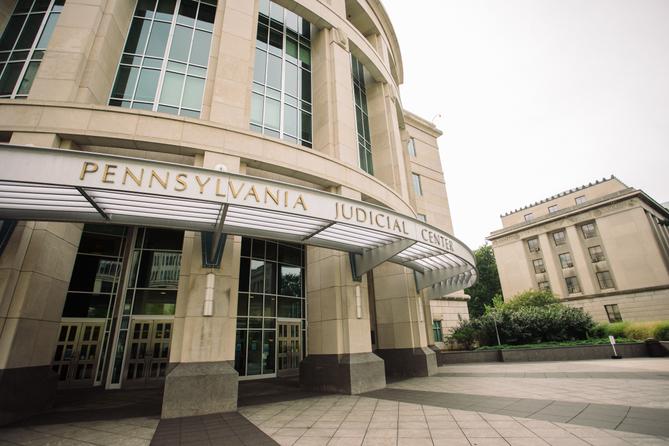This article is part of a yearlong reporting project focused on redistricting and gerrymandering in Pennsylvania. It’s made possible by the support of Spotlight PA members and Votebeat, a project focused on election integrity and voting access.
HARRISBURG — A proposal moving through the GOP-led Pennsylvania legislature could soon make the state an extreme outlier in the country by allowing lawmakers to exert more control over the state Supreme Court and other appellate courts.
The measure, which could be before voters as soon as May, calls for abolishing statewide elections for appellate court judges and replacing them with races in partisan districts determined by lawmakers and redrawn every 10 years.
A 50-state review by Spotlight PA and Votebeat, as well as interviews with judicial and academic experts, found only two other states — Illinois and Louisiana — employ such a system, which has increased partisan campaign fights and given special interests and dark money groups more of a foothold to affect the outcome of races.
Experts said the change in Pennsylvania could risk the public’s confidence in judges because they wouldn’t answer to a statewide constituency, but rather smaller, localized districts that are more politically homogeneous. That, in turn, could affect how they rule, eroding the judiciary’s independence and making it appear more political.
“The underlying assumption [of this proposal] is that judicial rulings, decisions, and the conduct of the judiciary should reflect some kind of partisan or ideological majority,” said Kent Redfield, a political science professor at the University of Illinois Springfield. “It’s antithetical to how judges should rule.”
The proposal — championed by Rep. Russ Diamond (R., Lebanon), a far-right member of the state legislature — most closely resembles the system in Illinois. With its partisan districts, the state has seen millions of dollars in dark money pumped into contentious — even fraudulent — elections as special interests vie for control of the highest court.
“All of those create circumstances under which one can introduce bias or create a situation where you have the appearance of bias,” Redfield said. “That’s not good for the health of the democratic institutions.”
Diamond and other Republicans contend electing appellate judges by districts rather than in statewide partisan contests — as is currently the process — will ensure that the state Supreme Court, Superior Court, and Commonwealth Court reflect the state’s diverse geography, and therefore its diverse judicial philosophies.
Currently, the majority of the 31 appellate court judges hail from the state’s two largest and most Democratic urban centers, Allegheny County and Philadelphia.
“We draft legislation to solve Pennsylvania’s problems, and I do not know whether any other states suffer with this particular problem,” Diamond said in an email.
Critics — including a wide array of legal organizations and good-government groups — call the measure a ploy for Republicans to gain more control over the Supreme Court, where Democrats in the majority have recently ruled against the GOP in election- and pandemic-related litigation.
Under Diamond’s proposal, which he has filed in every legislative session since 2015, lawmakers would redraw judicial districts every 10 years, as they do for congressional districts. The judicial maps would have to adhere to the same redistricting criteria outlined in the Pennsylvania Constitution, which requires lawmakers to draw districts that are roughly equal in population, compact, and contiguous, as well as avoid splitting localities “unless absolutely necessary.”
Despite those requirements, Pennsylvania lawmakers — who would be in charge of drawing the three appellate court maps — produced one of the most gerrymandered congressional maps in the country, which the state Supreme Court threw out in 2018.
Since the judicial districts would be established by law, the maps would require approval from the governor, according to Diamond.
“I envision input from the courts as well in the negotiations to establish that plan, which would bring all three branches of government together at a time when the commonwealth desperately needs such cooperation,” he said.
The manner of selecting judges has been highly debated across the country for decades, with states taking different approaches to appointing judges through merit selection or electing them either through partisan or nonpartisan races.
Twenty-eight states pick their Supreme Court justices through some combination of a commission that recommends candidates based on merit to the governor or legislature for appointment, at least for an initial term on the bench, according to the Brennan Center for Justice.
Six states, including Pennsylvania, hold partisan elections, and 15 hold nonpartisan elections, with one state — New Mexico — requiring justices to run in partisan elections after being appointed by the governor.
Four states — Mississippi, Kentucky, Louisiana, and Illinois — elect Supreme Court justices by district. The two states that most closely resemble Diamond’s proposal, Illinois and Louisiana, hold partisan district elections, but the lines have remained untouched for decades.
In Illinois, three of the seven Supreme Court justices are elected from Cook County — home to the heavily Democratic county seat of Chicago — and the rest are elected from districts that are supposed to be equal in population. But those districts haven’t been redrawn since 1963, resulting in uneven populations as residents have moved.
After 10 years on the bench, Illinois Supreme Court judges are subject to uncontested retention elections within their districts for additional 10-year terms, like Diamond is proposing for Pennsylvania.
In 2004, two judicial candidates spent at least $8.9 million on their campaigns in Illinois’ southern swing district. Court filings later revealed that the campaign of the winning candidate, Lloyd Karmeier, was secretly funded in part by State Farm in a bid to get a billion-dollar verdict against the company overturned.
In 2020, Republicans spent millions of dollars to prevent Illinois Supreme Court Justice Thomas Kilbride, a Democrat and the swing vote on the court, from being retained for another 10 years. Kilbride was the first justice in the state to lose a retention bid since the practice was first adopted in 1964, according to media reports.
In Louisiana, Supreme Court justices are elected to staggered 10-year terms from seven districts that haven’t been redrawn since 2000. All candidates compete in the same primary, and if no candidate gets more than 50% of the vote, the top two vote-getters advance to the general election.
New England Law professor Jordan Singer said having partisan elections in small geographic districts invites more campaign “mischief” than in a statewide race, because special interests are able to target their audience more narrowly, and there are fewer media markets to consider.
“It really opens the door for special interests and dark money to say, ‘Look, we can get a lot of bang for our buck by pouring money into this small region of the state, getting our candidate elected, and then that candidate will hopefully advance our interests,’” he said.
That’s not to say outsized spending doesn’t occur in statewide partisan races. Topping the spending in Illinois’ 2004 Supreme Court race was Pennsylvania’s 2015 contest, where candidates vying for three seats spent a combined $15.9 million, according to the Brennan Center.
Chris Bonneau, a political science professor at the University of Pittsburgh, said candidates win by larger margins in judicial districts, and there are fewer contested races because the districts are more politically homogeneous.
Redfield said district elections would probably produce few candidates that reflect the partisan or ideological “middle,” and more who win by running to the extreme left or right of their base, especially if the districts aren’t competitive.
He said introducing ideological advantages, such as redistricting, into judicial elections causes people to perceive judges as partisan actors who are beholden to constituencies, rather than as impartial judges who are impervious to outside influences.
“Redistricting becomes a way to make sure that the districts do not unfairly represent the interest of people, implicitly accepting the premise that judges represent people, not the law and the Constitution,” he said.
The Pennsylvania Constitution requires amendments to pass in the legislature twice in consecutive sessions before being placed on the ballot. After being approved by the General Assembly last year, Diamond’s measure narrowly passed a House committee earlier this month, with two Republicans siding with Democrats in voting against it.
If both chambers pass the measure by Feb. 17, the amendment would appear on the ballot for the May 18 primary. Its next step is a vote on the House floor, though Diamond said Tuesday he does not know when leadership plans to bring the measure up for a vote. A spokesperson for House Majority Leader Kerry Benninghoff (R., Centre) did not respond to a request for comment.
Jane Cutler Greenspan, a retired Democratic Supreme Court justice from Philadelphia appointed by Gov. Ed Rendell, said she thought about rural counties that weren’t like her home base when she made decisions that impacted the entire state.
Greenspan, who opposes Diamond’s constitutional amendment, said that wouldn’t necessarily be the case if she had been elected by a district.
“If I was just beholden to the electorate in Philadelphia, that’s pretty much where I would vote,” she said. “You’ll have justices not considering other districts.”
100% ESSENTIAL: Spotlight PA relies on funding from foundations and readers like you who are committed to accountability journalism that gets results. Become a member today at spotlightpa.org/donate.

